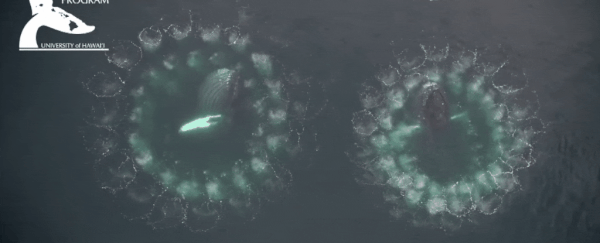Did you know some cetaceans use "nets" to catch their food? Like humpback whales. They'll dive down and swim in a ring around their prey, blowing out bubbles as they go.
That rising ring forms a column that traps fish, allowing other whales in the group to swim up from below, mouths agape, through the bubble cylinder to feast.
It's an absolutely fascinating and beautiful thing to watch - and scientists have caught it on camera in a rare whale's-eye view.
In addition to drone footage showing a stunning overhead view of a pair of humpback whales (Megaptera novaeangliae) creating the bubble nets, marine biologists at the University of Hawaiʻi at Mānoa stuck cameras and sensors on whales using suction cups to collect a wealth of data on the fascinating behaviour.
"We have two angles. The drone's perspective is showing us these bubble nets and how the bubbles are starting to come to the surface and how the animals come up through the bubble net as they surface, while the cameras on the whales are showing us the animal's perspective," said marine biologist Lars Bejder of the university's Marine Mammal Research Program.
"Overlaying these two data sets is quite exciting."

Migratory humpback whales visit Alaska to feed during the Summer, before heading back down to the warmer waters around Hawaii for the Winter, where they will breed and raise their calves.
During this breeding period, the whales don't really eat, so they need to stock up on huge reserves of Alaskan krill to keep going over this energy-expensive time.
To find out how the whales use this hunting technique to get enough to eat, the researchers fitted them with cameras and accelerometers, and took accompanying drone video from above.
What's fascinating about bubble net feeding is that it seems to be a learned behaviour. Not all humpback whales hunt this way, and those that do can have varying techniques. It's also cooperative, with the whales working together to make sure everyone gets fed.
We've also seen Bryde's whales (Balaenoptera edeni) feeding this way, and bottlenose dolphins (genus Tursiops) off the coast of Florida use a similar cooperative hunting technique called mud-ring feeding, where they stir up a ring of sediment from the floor of shallow waters to trap schooling fish.
Humpback whale numbers increased after a ban on commercial whaling in 1985, and are no longer considered endangered, but in the last five years, there has been a substantial decline in humpback whale sightings.
This research into feeding techniques is part of an attempt to figure out why that might be, with potential causes including changes to food populations, anthropogenic impacts on their habitat, and climate breakdown.
"The footage is rather groundbreaking," Bejder said. "We're observing how these animals are manipulating their prey and preparing the prey for capture. It is allowing us to gain new insights that we really haven't been able to do before."
